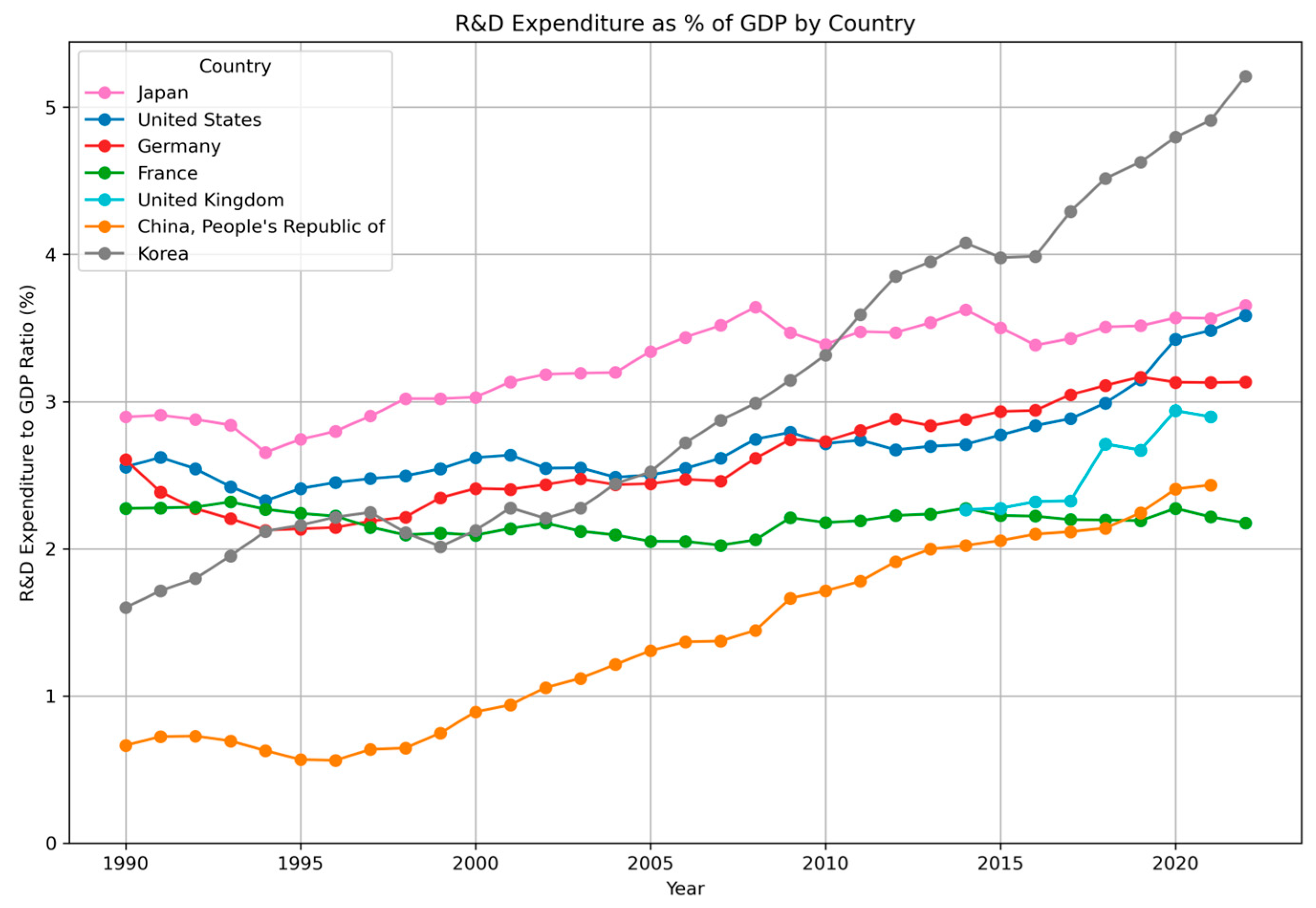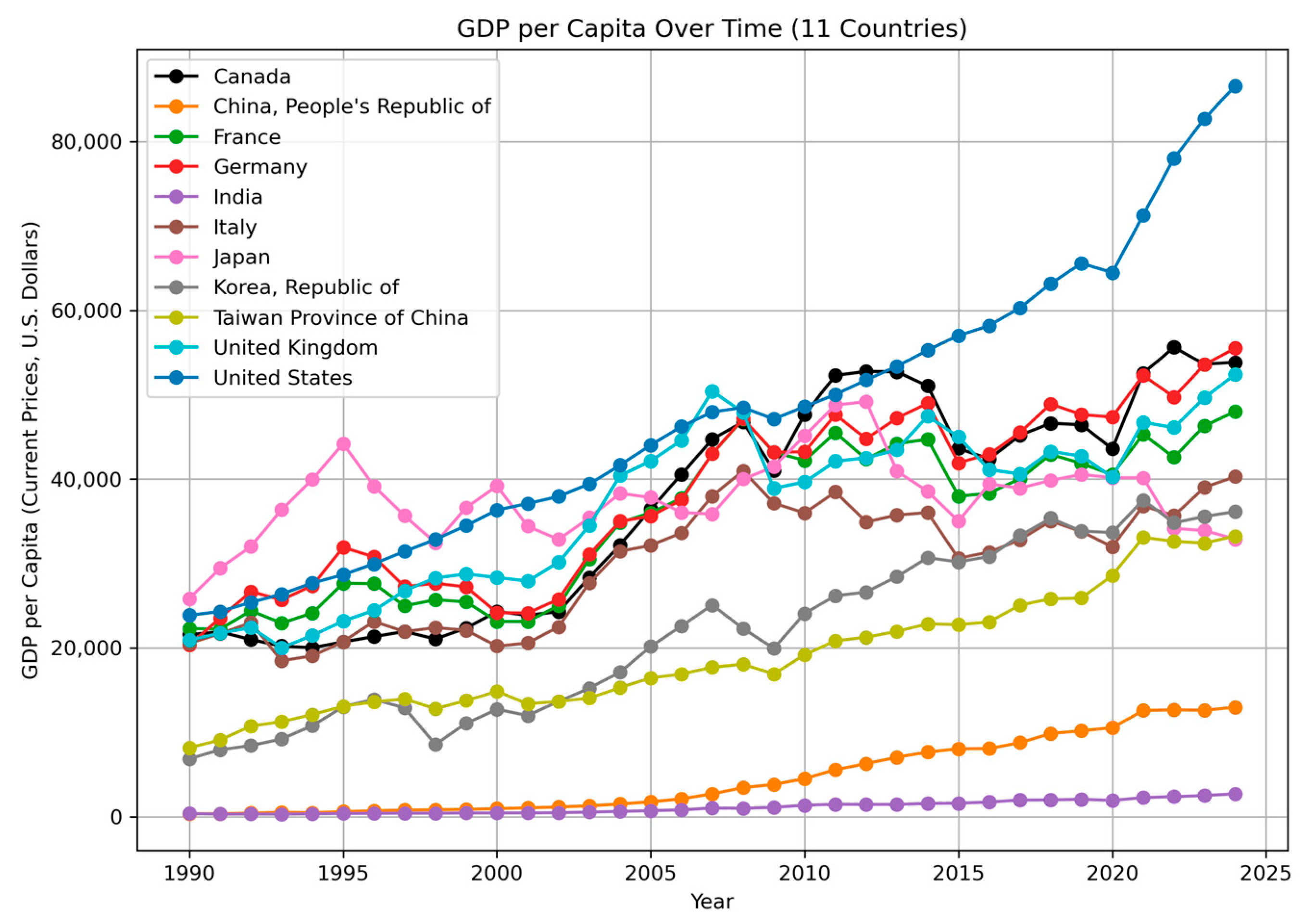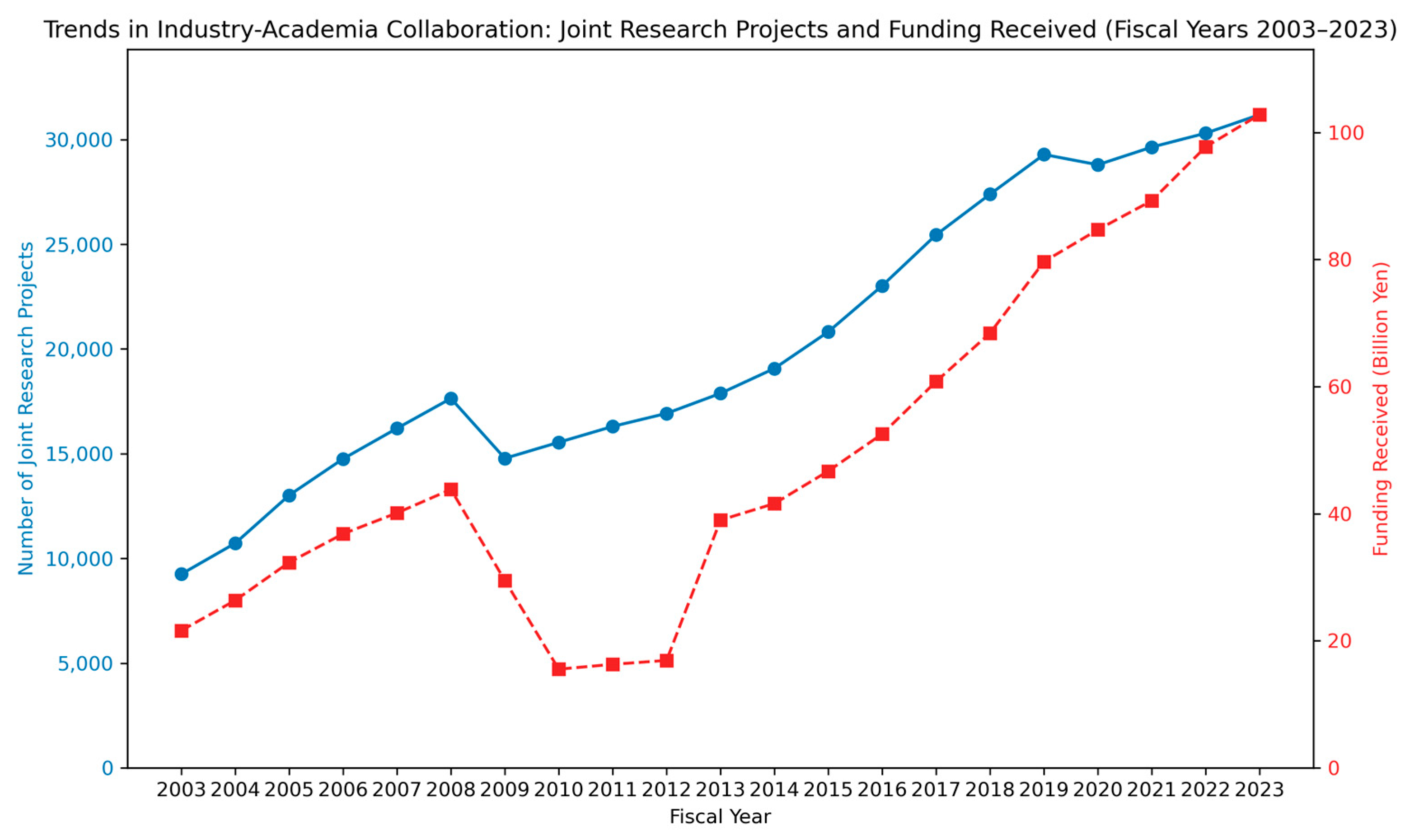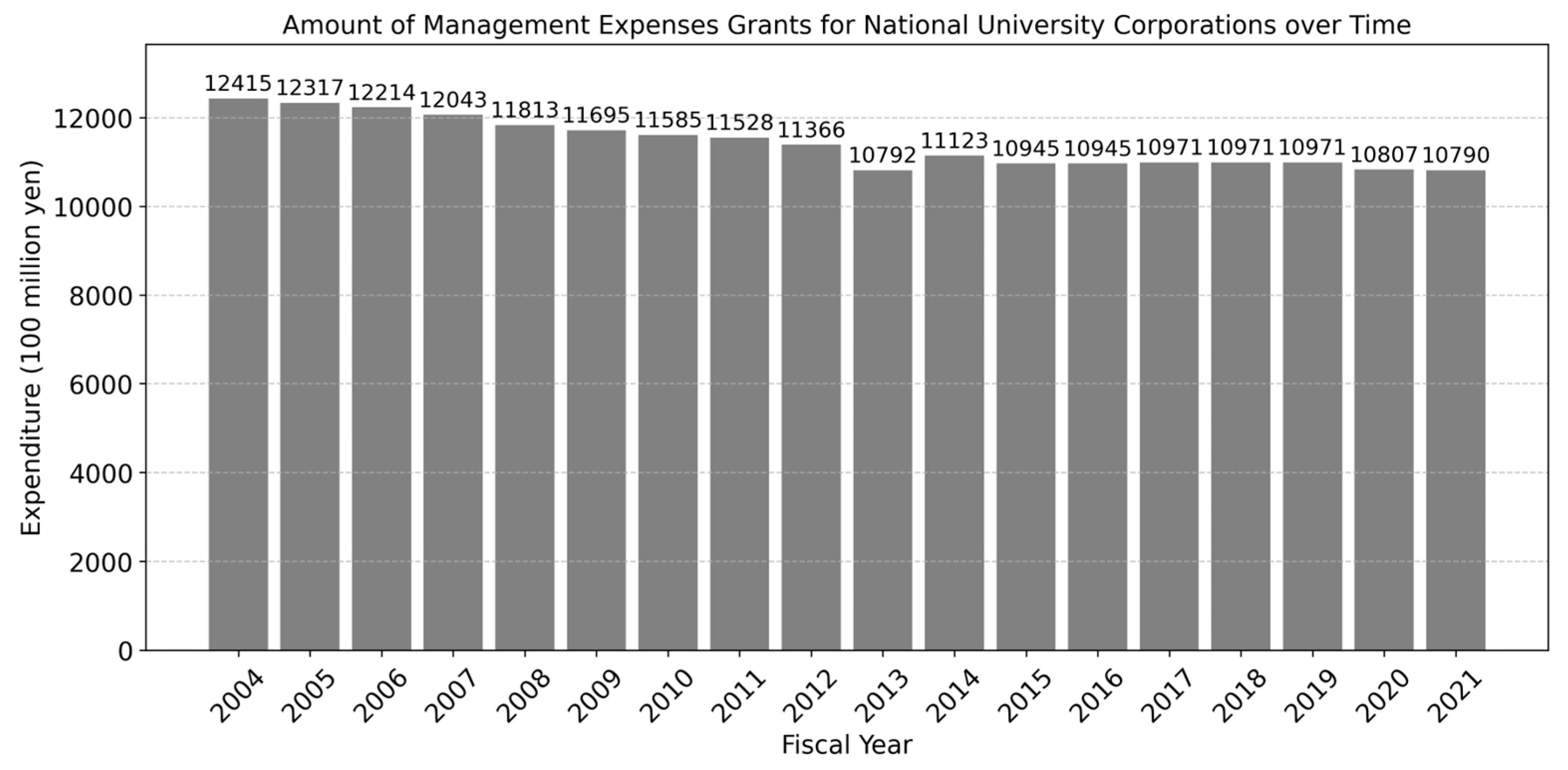Japanese Science Policies and Their Impacts on Scientific Research
Abstract
1. Introduction
2. Analytical Framework
3. Japan: Science and Technology-Driven Country
4. Stagnation of Economy and Decrease in Scientific Strength in Japan
5. Corporatization of National Universities: Intended Reforms and Unintended Consequences
6. “Selection and Concentration”: A Shift Toward Top–Down, Targeted Budget Allocation Prioritizing Specific Research Areas
7. The Introduction of Fixed-Term Employment at National and Public Universities and Its Drawbacks
8. Non-Renewal of Contracts and Its Negative Effect on the Sustainability of Japanese Science
9. Expansion of Graduate Education and the “10,000 Postdocs Project” and Their Consequences
10. Decreased Number of Graduate Students, the Core Driving Force of Research
11. Declining Research Time Amid Increasing Administrative Demands
12. Expectation for the Research Administrators (URAs) for the Support of Researchers in Academia
13. Maximizing the Possibility for Innovation to Happen: Rebalancing Japan’s Research Funding
14. Japan’s Unique Challenges
15. Limitations and Future Directions
15.1. Limitations of the Present Study
15.2. Directions for Future Research
16. Conclusions
Funding
Data Availability Statement
Acknowledgments
Conflicts of Interest
Abbreviations
| GDP | gross domestic product |
| MEXT | Ministry of Education, Culture, Sports, Science, and Technology |
| CSTI | Council for Science, Technology, and Innovation, Cabinet Office |
| URA | University Research Administrator |
| NISTEP | National Institute of Science and Technology Policy |
| EPMEWSE | Japan Inter-Society Liaison Association Committee for Promoting Equal Participation of Men and Women in Science and Engineering |
References
- Aagaard, K., Kladakis, A., & Nielsen, M. W. (2019). Concentration or dispersal of research funding? Quantitative Science Studies, 1, 117–149. [Google Scholar] [CrossRef]
- Amano, I. (2006). Corporatization of national universities: Current status and challenges (国立大学の法人化: 現状と課題). Nagoya Journal of Higher Education, 6, 147–169. [Google Scholar]
- Asahi Shimbun Investigative Team. (2024). The national universities at the brink: Twenty Years after corporatization, What is eroding Japan’s universities? (限界の国立大学——法人化20年, 何が最高学府を劣化させるのか?). Asahi Shimbun Investigative Team. [Google Scholar]
- Asia Pacific Dept International Monetary Fund (IMF). (2023). Structural barriers to wage income growth in Japan. IMF Staff Country Reports, 2023, A003. [Google Scholar]
- Blackburn, R. T., & Lawrence, J. H. (1986). Aging and the quality of faculty job performance. Review of Educational Research, 56, 265–290. [Google Scholar] [CrossRef]
- Castellacci, F., & Viñas-Bardolet, C. (2021). Permanent contracts and job satisfaction in academia: Evidence from European countries. Studies in Higher Education, 46, 1866–1880. [Google Scholar] [CrossRef]
- Cole, S. (1979). Age and scientific performance. American Journal of Sociology, 84, 958–977. [Google Scholar] [CrossRef]
- CSTI. (2013). “Actions by CSTI and related bodies leading up to the amendment of the labor contract act”, expert–lawmaker roundtable (December 19, 2013): “On special provisions of the labor contract act”, meeting materials 1–7 (「労働契約法改正に伴う総合科学技術会議等の動き」, 総合科学技術会議 有識者議員懇談会「労働契約法の特例について」平成25年12月19日 会議資料 1–7). Available online: https://www8.cao.go.jp/cstp/gaiyo/yusikisha/20131219/cho1-7_sanko1.pdf (accessed on 22 May 2025).
- Cyranoski, D. (2001). Scientists fear new guidelines will stifle basic research. Nature, 412, 364–364. [Google Scholar] [CrossRef]
- Enoki, E. (2001). Japan’s funding cuts hit the future of science. Nature, 414, 485–485. [Google Scholar] [CrossRef]
- Enoki, E., & Hamanaka, J. (2014). The reality of underutilized highly educated talent in Japan: Why do Japanese companies not recruit and utilize PhD holders? Works, 6–8. Available online: https://www.works-i.com/works/item/w_126.pdf (accessed on 22 May 2025).
- EPMEWSE. (2023). First survey analysis report—Working group on employment issues of young researchers. In The Japan inter-society liaison association committee for promoting equal participation of men and women in science and engineering (EPMEWSE). EPMEWSE. [Google Scholar]
- Gokami, M. (2019). The future landscape of universities: Creating a knowledge-based society (大学の未来地図: 「知識集約型社会」を創る). Chikumashobo Ltd. [Google Scholar]
- Gurdon, J. B. (1962). The developmental capacity of nuclei taken from intestinal epithelium cells of feeding tadpoles. Development, 10, 622–640. [Google Scholar] [CrossRef]
- Hanawa, T. (2021). Repayment resources of “University Bond” and equal opportunity of the national university corporations in Japan; reviewing the revenue bonds of public universities in the United States. The Annual Bulletin of Social Science, 55, 161–178. [Google Scholar]
- Hirao, T., & Hoshino, Y. (2024). The dysfunction of mission-oriented innovation policy: Impeding the accumulation of scientific knowledge in the Japanese Academic Sector. Administrative Sciences, 14, 115. [Google Scholar] [CrossRef]
- Hornyak, T. (2022). ‘I feel disposable’: Thousands of scientists’ jobs at risk in Japan. Nature. [Google Scholar] [CrossRef]
- Igami, M. (2017). A consideration on the background of the recent stagnation of Japanese scientific research: Evidence from research results of the National Institute of Science and Technology Policy (NISTEP) 日本の科学研究力の停滞の背景をよむ: 科学技術・学術政策研究所の調査研究より. Kagaku, 87, 744–755. [Google Scholar]
- Igami, M., & Kanda, Y. (2024). Temporal changes in R&D expenditures at the university faculty level: A trial using the survey of research and development. In Nistep discussion paper. National Institute of Science and Technology Policy. [Google Scholar]
- Ikarashi, A. (2023). Japanese research is no longer world class—Here’s why. Nature, 623, 14–16. [Google Scholar] [CrossRef]
- Institute for Future Engineering. (2018). Report on the survey analysis for quality assurance of research administrators: FY 2017 MEXT commissioned project (平成 29 年度文部科学省委託事業 リサーチ・アドミニストレーターの質保証に 向けた調査分析 調査報告書). Institute for Future Engineering. [Google Scholar]
- Ishino, Y., Krupovic, M., & Forterre, P. (2018). History of CRISPR-Cas from encounter with a mysterious repeated sequence to genome editing technology. Journal of Bacteriology, 200, e00580-17. [Google Scholar] [CrossRef]
- Ito, T. (2024). URA as a catalyst for innovation in Japan: From the case study of Kyoto university. The Journal of Information Science and Technology, 74, 22–27. [Google Scholar]
- Iwamoto, N. (2019). Scientists are disappearing: Japan may no longer win Nobel prizes (科学者が消える: ノーベル賞が取れなくなる日本). Toyo Keizai Inc. [Google Scholar]
- Japan Cabinet Office. (2013). “The awarding of the Nobel prize in physiology or medicine to professor Shinya Yamanaka of Kyoto University”, document 7: Reference material for handout 3—“The project for realization of regenerative medicine”, distributed at the 104th meeting of the expert panel on evaluation, council for science, technology and innovation (CSTI), cabinet office, government of Japan. (総合科学技術・イノベーション会議 評価専門調査会 (第 104 回) 配布資料 資料3参考 「再生医療の実現化プロジェクト」について 文書 PDF 7 山中伸弥京大教授のノーベル生理学・医学賞受賞について). Available online: https://www8.cao.go.jp/cstp/tyousakai/hyouka/haihu104/siryo3sg.pdf (accessed on 22 May 2025).
- Japan Cabinet Office, Council for Science and Technology Policy. (2016). The fifth science and technology basic plan. Japan Cabinet Office, Council for Science and Technology Policy. [Google Scholar]
- Japan Cabinet Office, Council for Science and Technology Policy. (2021). The sixth science and technology basic plan. Japan Cabinet Office, Council for Science and Technology Policy. [Google Scholar]
- Kanai, Y. (2024). Employment and research at RIKEN: Researchers and technicians treated as disposable labor (理化学研究所における雇用と研究: 使い捨てられる研究者・技術者). Journal of Japanese Scientists, 59, 574–579. [Google Scholar]
- Kanda, Y., & Igami, M. (2020). Detailed analyses on full-time equivalent R&D expenditure and the number of researchers in Japanese universities. In Technical report. National Institute of Science and Technology Policy (NISTEP). [Google Scholar]
- Katayama, S. (2022). Mass non-renewals of researchers and faculty at national university corporations and R&D organizations (国立大学法人, 研究開発法人等における研究者, 教員の大量雇止め). Journal of Japanese Scientists, 57, 44–45. [Google Scholar]
- Kobayashi, T. (2016). The postdoc problem and workforce mobility: Saving Japanese science (ポスドク問題と人材の流動化—日本のサイエンスを救うために—). Science Portal (Japan Science and Technology Agency). [Google Scholar]
- Kondo, A. (2016). The legal nature of the civil service working relationship. Chuo Law Review, 123, 339–369. [Google Scholar]
- Maeda, T. (1997). Implementation of Japan’s fixed-term faculty act and emerging issues related to non-tenured academic positions (大学教員任期法の施行と任期制をめぐる今後の課題). University Journal, 21, 1–10. [Google Scholar]
- Mainichi Shimbun Investigative Team. (2019). The decline and fall of the Japanese scientific empire. The Mainichi Newspapers Co., Ltd. [Google Scholar]
- Matsuzawa, T. (2019). Survey for the career path of PhD students: Interest in transferable skills, and awareness of overseas students. In Nistep discussion paper. Available online: https://nistep.repo.nii.ac.jp/records/6662 (accessed on 22 May 2025).
- MEXT. (2014a). Guidelines for responding to misconduct in research. MEXT. [Google Scholar]
- MEXT. (2014b). Survey on the employment and career paths of postdoctoral researchers—A complete survey of universities and public research institutions (FY2012 data) (ポストドクター等の雇用・進路に関する調査 -大学・公的研究機関への全数調査 (2012 年度実績). MEXT. [Google Scholar]
- MEXT. (2018a). Historical developments and potential structural causes of the decline in Japan’s research capability: Document 2-2 for the 68th meeting of the subdivision on science of the council for science and technology, July 3, 2018. MEXT. [Google Scholar]
- Overview of the key developments and structural factors behind Japan’s declining research capacity (reference data collection) (日本の研究力低下の主な経緯・構造的要因案 (参考データ集). (2018b). In Materials for the 68th academic subcommittee meeting. MEXT (Ed.). Ministry of Education, Culture, Sports, Science and Technology. [Google Scholar]
- MEXT. (2022). Minutes of the 93rd meeting of the committee on human resources, council for science and technology. ministry of education, culture, sports, science and technology (25 April 2022) (文部科学省 科学技術・学術審議会 人材委員会 (第93回) 議事録 令和4年4月25日). MEXT. [Google Scholar]
- MEXT. (2023). The historical development of national university corporatization in Japan (国立大学の法人化の経緯). MEXT. [Google Scholar]
- MEXT. (2024). On the allocation of grants-in-aid for scientific research (KAKENHI), FY2024 (科学研究費助成事業の配分について). Available online: https://www.mext.go.jp/content/20250331-mxt_gakjokik-000036204_1.pdf (accessed on 22 May 2025).
- MEXT. (2025a). FY2023 survey on full-time equivalent (FTE) data in universities and related institutions (令和5年度 大学等におけるフルタイム換算データに関する調査). MEXT. [Google Scholar]
- MEXT. (2025b). Reference material 1: Related data collection, distributed materials for the joint meeting of the 181st subdivision on universities and the 15th special committee on the future of higher education, January 28, 2025 (大学分科会 (第181回)・高等教育の在り方に関する特別部会 (第15回) 合同会議配付資料 令和7年1月28日【参考資料1】関係データ集). MEXT. [Google Scholar]
- MEXT & Science and Technology Policy Bureau (Eds.). (2020). Call for proposals: University fellowship program for the creation of science, technology, and innovation (科学技術イノベーション創出に向けた大学フェローシップ創設事業 公募要領). Ministry of Education, Culture, Sports, Science and Technology. [Google Scholar]
- Ministry of Internal Affairs and Communications. (2016). Survey report on the promotion of innovation policy (イノベーション政策の推進に関する調査結果報告書) (総務省行政評価局). Ministry of Internal Affairs and Communications.
- Mitsubishi Research Institute Inc. (2016). Analysis of government R&D investment target setting and investment effects (Translation of Japanese). In Investigation and analysis report on policy issues concerning the promotion of “Science for Policy” in science and technology innovation policies (政府研究開発投資目標の設定・投資効果の分析 科学技術イノベーション政策における「政策のための科学」推進に関する政策課題についての調査分析). Mitsubishi Research Institute. [Google Scholar]
- Mitsubishi Research Institute Inc. (2017). Survey report on the challenges for strengthening the URA system (URAシステム強化に向けた諸課題に関する調査). In MEXT FY2016 commissioned project for the development of science and technology human resources. MIT Press. [Google Scholar]
- Miyaki, M. (2024). Performance-based allocation of management expenses grants to national university corporations: An analysis and assessment focused on core funding during the third mid-term plan period (国立大学法人運営費交付金における業績連動型配分の実態と検証―第3期中期目標期間中の基幹経費に着目して―). IERCU Discussion Paper, 404. Available online: https://chuo-u.repo.nii.ac.jp/records/2001765 (accessed on 22 May 2025).
- Mizuta, K. (2024). Historical transitions in critical issues of national university corporations’ finance 国立大学法人の制度・会計・財務状況に関する論点と変遷. The Doshisha Business Review, 75, 591–627. [Google Scholar]
- Monde, K. (2024). More research time for researchers (研究者にもっと研究時間を). Journal of Synthetic Organic Chemistry, 82, 115. [Google Scholar] [CrossRef]
- Motomura, Y. (2009). What exactly was the strategic focus on graduate schools? Chemistry & Chemical Industry, 62, 873–876. [Google Scholar]
- Murata, H. (2021). Promoting university bonds and academia-industry collaboration: Reflections on six years as president of the university of Tokyo—Makoto gonokami on the university’s role as a driver of societal transformation (大学債発行、産学連携を推進-。総長在任6年を総括 変革期の大学の使命 東京大学総長・五神真の「大学は、社会変革を駆動する拠点として」). Zaikai, 69, 16–21. [Google Scholar]
- Nagane, H. (2024). Training and deployment of Ph.D. talent: Attaining equilibrium in Ph.D. labor market (博士人材の育成と活用: 博士労働市場の均衡にむけて). The Journal of Information Science and Technology. Available online: https://doi.org/10.18919/jkg.74.1_8 (accessed on 22 May 2025). [CrossRef]
- Nakatomi, K. (2011). Restructuring of academic freedom in national university corporations. The Quarterly of the Ritsumeikan University Law Association, 333, 2495–2523. [Google Scholar]
- Nakayama, R. (2020). “The corporatization of national universities was a failure”—Regret expressed by Akito arima, former president of the university of Tokyo and former minister of education (「国立大学法人化は失敗だった」 有馬朗人元東大総長・文相の悔恨). In Nikkei business. Available online: https://business.nikkei.com/atcl/gen/19/00158/051900003/ (accessed on 22 May 2025).
- National Institute of Science and Technology Policy (NISTEP). (2024). Japanese science and technology indicators 2024. National Institute of Science and Technology Policy. [Google Scholar]
- NISTEP. (2023). Survey on career awareness and financial assistance to 1st year of doctoral students—A survey from december 2022 to January 2023. National Institute of Science and Technology Policy. [Google Scholar]
- NISTEP. (2024a). The 2021 survey on postdoctoral fellows regarding employment and careers in Japan. NISTEP. [Google Scholar]
- NISTEP. (2024b). Analytical report of comprehensive survey on the state of science and technology in Japan (NISTEP TEITEN Survey 2023). In Nistep report. NISTEP. [Google Scholar]
- Ohniwa, R. L., Takeyasu, K., & Hibino, A. (2023). The effectiveness of Japanese public funding to generate emerging topics in life science and medicine. PLoS ONE, 18, e0290077. [Google Scholar] [CrossRef]
- Okazaki, T., & Honjo, T. (2007). PD-1 and PD-1 ligands: From discovery to clinical application. International Immunology, 19, 813–824. [Google Scholar] [CrossRef]
- Okumura, S., & Ikuta, C. (2021). Report on the career path survey—From the 24th subcommittee on astronomy and astrophysics, science council of Japan. The Astronomical Herald, 114, 11. [Google Scholar]
- Omi, K. (1996). Fundamental law of science and technology. Yomiuri Shimbun. [Google Scholar]
- Osumi, Y. (2023). Interview with professor yoshinori ohsumi, honorary professor at tokyo institute of technology (東京工業大学栄誉教授 大隅良典先生 インタビュー). Trends in the Sciences, 28, 4_12–4_24. [Google Scholar]
- Sabharwal, M. (2013). Comparing research productivity across disciplines and career stages. Journal of Comparative Policy Analysis: Research and Practice, 15, 141–163. [Google Scholar] [CrossRef]
- Sasaki, D. (2018). The 2018 issue at national universities and its resolution: A case study of the university of Tokyo (国立大学における二〇一八年問題とその解決│東京大学の事例). The Zenei, 1–8. Available online: https://jww.iss.u-tokyo.ac.jp/doc/201804ZE18_sasaki.pdf (accessed on 22 May 2025).
- Sawamoto, N., Doi, D., Nakanishi, E., Sawamura, M., Kikuchi, T., Yamakado, H., Taruno, Y., Shima, A., Fushimi, Y., Okada, T., Kikuchi, T., Morizane, A., Hiramatsu, S., Anazawa, T., Shindo, T., Ueno, K., Morita, S., Arakawa, Y., Nakamoto, Y., … Takahashi, J. (2025). II trial of iPS-cell-derived dopaminergic cells for Parkinson’s disease. Nature, 641, 971–977. [Google Scholar] [CrossRef]
- Science and Technology Policy Symposium Executive Committee. (2010). Recommendations for addressing the issues facing young researchers (e.g., postdocs). Science and Technology Policy Symposium Executive Committee. [Google Scholar]
- Science Council of Japan. (2019). Proposals toward the 6th basic plan for science and technology. Available online: https://www.scj.go.jp/ja/info/kohyo/pdf/kohyo-24-t283-1.pdf (accessed on 22 May 2025).
- scienceinjapan.org. (2024). Survey results on the so-called “Non-Renewal Problem” at universities and research institutions. Available online: https://scienceinjapan.org/site/wp-content/uploads/2024/10/pub6_104.pdf (accessed on 22 May 2025).
- Shimada, S. (2022, November 30–December 3). Toward the revival of Japan as a nation of science and technology—Is Japan finished? 96th Annual Meeting of the Japanese Pharmacological Society (vol. 96, p. 2-B-SL09), Yokohama, Japan. [Google Scholar]
- Shimomura, O. (2005). The discovery of aequorin and green fluorescent protein. Journal of Microscopy, 217, 1–15. [Google Scholar] [CrossRef]
- Soma, T., Oie, Y., Takayanagi, H., Matsubara, S., Yamada, T., Nomura, M., Yoshinaga, Y., Maruyama, K., Watanabe, A., Takashima, K., Mao, Z., Quantock, A. J., Hayashi, R., & Nishid, K. (2024). Induced pluripotent stem-cell-derived corneal epithelium for transplant surgery: A single-arm, open-label, first-in-human interventional study in Japan. The Lancet, 404, 1929–1939. [Google Scholar] [CrossRef] [PubMed]
- Statistics Bureau of Japan. (2024). Results of the survey of research and development FY2024 (Reiwa 6). Statistics Bureau of Japan. [Google Scholar]
- Suda, M. (2021). The transformation of the “Control Tower” for science and technology and the decline of Japan’s research capabilities (「科学技術の司令塔」の変質と日本の研究力衰退). Gakujutsu No Doko, 26. [Google Scholar] [CrossRef]
- Takahashi, K. (2023a). The validity of non-renewal in relation to the right to request conversion to an indefinite-term contract—An analysis of recent judicial precedents concerning the right to request indefinite-term conversion—(無期転換申込権に関連する雇止めの有効性: 無期転換申込権に関する最近の裁判例の分析). Chuo Law Review, 129, 443–473. [Google Scholar]
- Takahashi, M. (2023b). Research managers and administrators in Asia: History and future expectations. In S. Kerridge, S. Poli, & M. Yang-Yoshihara (Eds.), The emerald handbook of research management and administration around the world. Emerald Publishing Limited. [Google Scholar]
- Takahashi, M. (2016). The function of URA skill standard for unified comprehension to diversified roels of URAs and related professionals. Journal of the Japan Society for Intellectual Production, 12, 19–29. [Google Scholar]
- Takahashi, M., Furusawa, Y., Edamura, K., & Sumikura, K. (2018). Human resources for research promotion and application in Japanese academia-from competition to cooperation of university-industry cooperation coordinators and university research administrators-. In Grips discussion paper. National Graduate Institute for Policy Studies (GRIPS). [Google Scholar]
- Takahashi, M., & Ito, S. (2023). The profession of research management and administration in Japan. In S. Kerridge, S. Poli, & M. Yang-Yoshihara (Eds.), The emerald handbook of research management and administration around the world. Emerald Publishing Limited. [Google Scholar]
- Takeuchi, K. (2019). The future of management expense grants for national university corporations: Debates over performance-based allocation (国立大学法人運営費交付金の行方: 「評価に基づく配分」をめぐって). Legislation and Research (立法と調査), 67–76. Available online: https://dl.ndl.go.jp/pid/12980187/1/1 (accessed on 22 May 2025).
- The National Diet of Japan. (2003). Supplementary resolutions to the national university corporation act. Available online: https://www.sangiin.go.jp/japanese/joho1/kousei/gian/156/pdf/k031560561560.pdf (accessed on 22 May 2025).
- The Science Council of Japan’s Executive Committee. (2022). Statement by the executive board of the science council of Japan: Aiming to resolve the so-called “Yatoi-dome” (Non-Renewal) issue for fixed-term researchers and university faculty (有期雇用研究者・大学教員等のいわゆる「雇止め」問題の解決を目指して). Trends in the Sciences, 27, 7–9. [Google Scholar]
- Tomizawa, H. (2025). Causes and effects of Japan’s stagnation in research capacity. The Journal of Science Policy and Research Management, 40, 2–4. [Google Scholar]
- Toyoda, N. (2019). Japan’s crisis as a science and technology powerhouse (科学立国の危機 失速する日本の研究力). Toyo Keizai Inc. [Google Scholar]
- Watanabe, C., & Hemmert, M. (1998). The interaction between technology and economy. In M. Hemmert, & C. Oberländer (Eds.), Technology and innovation in Japan: Policy and management for the twenty-first century. Routledge. [Google Scholar]
- Watanabe, E., Kawamura, M., & Tsuchiya, T. (2023). The 2021 Survey of Japan Master’s human resource profiling. In Nistep research material. National Institute of Science and Technology Policy. [Google Scholar]
- Yamagiwa, J., & Fujii, S. (2018). Interview with Kyoto university president Juichi Yamagiwa: Japan’s universities are being destroyed by “Austerity” and “Reform” (京都大学 山極寿一総長インタビュー 日本の大学は今、「緊縮」と「改革」で滅びつつある). Criterion, 134–148. Available online: https://the-criterion.jp/mail-magazine/m20181022/ (accessed on 22 May 2025).
- Yamamoto, K. (Ed.). (2007). A study on the financial and managerial reforms following the corporatization of national universities (国立大学法人化後の財務・経営に関する研究). National Institution for Academic Degrees and Quality Enhancement of Higher Education. Available online: https://www.niad.ac.jp/publication/sonota/pub_zam/report/n000f006.html (accessed on 22 May 2025).
- Yamanaka, S. (2020). Pluripotent stem cell-based cell therapy-promise and challenges. Cell Stem Cell, 27, 523–531. [Google Scholar] [CrossRef]
- Yamano, M. (2016). Comparative understanding of change of university research administrators (URA) between Japan and the USA: Expansion of the role of research development (RD). The Journal of Management and Policy In Higher Education, 67–82. [Google Scholar] [CrossRef]
- Yang-Yoshihara, M., Poli, S., & Kerridge, S. (Eds.). (2023). Evolution of professional identity in research management and administration. In The emerald handbook of research management and administration around the world. Emerald Publishing Limited. [Google Scholar]
- Yano, M., Murakami, T., & Hayashi, T. (2013). The current situation and system design of research administration in Japan 我が国のリサーチ・アドミニストレーターの現状と制度設計: 東京大学の事例を中心として. Research in Higher Education, 45, 83–96. [Google Scholar]
- Yomiuri Shimbun. (2018). Exchange of opinions, No. 41 “corporatization was inevitable—The strongest scenario for all national universities” an interview withMakoto Gonokami, president of the University of Tokyo (異見交論41「法人化は必然 全国立大で最強のシナリオ」五神 真氏 (東京大学学長). Available online: https://kyoiku.yomiuri.co.jp/rensai/contents/41-1.php (accessed on 22 May 2025).
- Yonezawa, A. (2020). Challenges of the Japanese higher education Amidst population decline and globalization. Globalisation, Societies and Education, 18, 43–52. [Google Scholar] [CrossRef]
- Yoshida, K. (2007). Chapter 10: Management expense grants and independent revenue (第10章 運営費交付金と自己収入). In K. Yamamoto (Ed.), A study on the financial and managerial reforms following the corporatization of national universities (Translation of Japanese 国立大学法人化後の財務・経営に関する研究). National Institution for Academic Degrees and Quality Enhancement of Higher Education. Available online: https://www.niad.ac.jp/publication/sonota/pub_zam/report/n000f006.html (accessed on 22 May 2025).
- Young Academy of Japan. (2014). Proposal of a methodology for enhancing japan’s science and technology through support for early-career researchers and the utilization of research support personnel (若手研究者支援・研究支援人材活用を通じた日本の科学技術を高めていく方法論の提案). Science Council of Japan. [Google Scholar]






Disclaimer/Publisher’s Note: The statements, opinions and data contained in all publications are solely those of the individual author(s) and contributor(s) and not of MDPI and/or the editor(s). MDPI and/or the editor(s) disclaim responsibility for any injury to people or property resulting from any ideas, methods, instructions or products referred to in the content. |
© 2025 by the author. Licensee MDPI, Basel, Switzerland. This article is an open access article distributed under the terms and conditions of the Creative Commons Attribution (CC BY) license (https://creativecommons.org/licenses/by/4.0/).
Share and Cite
Muto, A. Japanese Science Policies and Their Impacts on Scientific Research. Publications 2025, 13, 27. https://doi.org/10.3390/publications13020027
Muto A. Japanese Science Policies and Their Impacts on Scientific Research. Publications. 2025; 13(2):27. https://doi.org/10.3390/publications13020027
Chicago/Turabian StyleMuto, Akira. 2025. "Japanese Science Policies and Their Impacts on Scientific Research" Publications 13, no. 2: 27. https://doi.org/10.3390/publications13020027
APA StyleMuto, A. (2025). Japanese Science Policies and Their Impacts on Scientific Research. Publications, 13(2), 27. https://doi.org/10.3390/publications13020027





